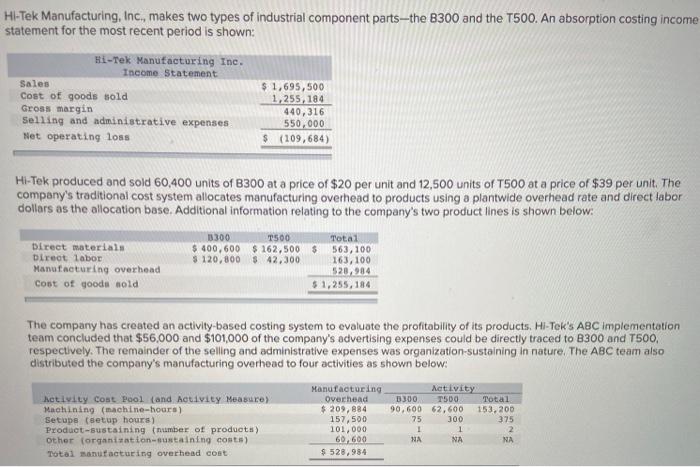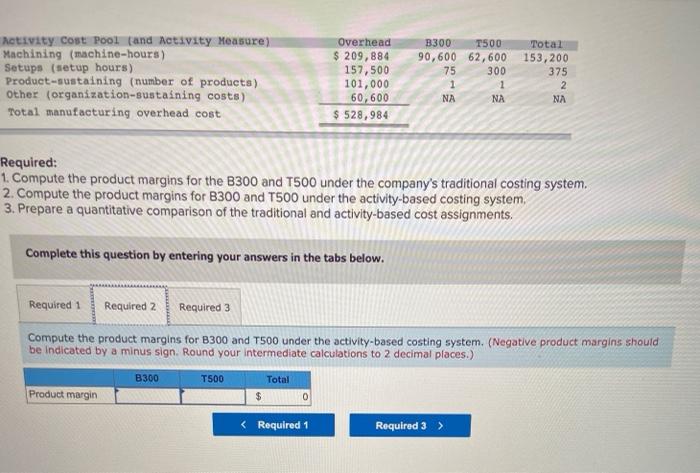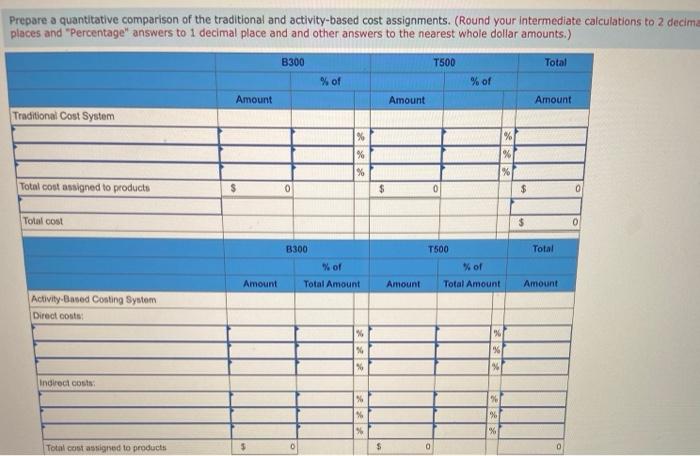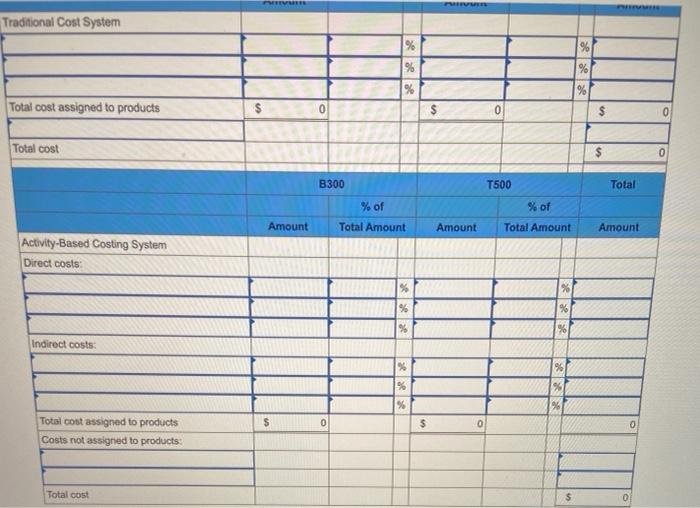Hi-Tek Manufacturing, Inc., makes two types of industrial component parts-the 8300 and the T500. An absorption costing income statement for the most recent period is shown: Hi-Tek Manufacturing Inc. Income Statement Sales $1,695,500 Cost of goods sola 1,255, 184 Gross margin 440,316 Selling and administrative expenses 550,000 Net operating loss $ (109,684) Hi-Tek produced and sold 60,400 units of B300 at a price of $20 per unit and 12,500 units of T500 at a price of $39 per unit. The company's traditional cost system allocates manufacturing overhead to products using a plantwide overhead rate and direct labor dollars as the allocation base. Additional information relating to the company's two product lines is shown below: Direct materials Direct labor Manufacturing overhead Cost of goods sola 3300 T500 Total $ 400,600 $ 162,500 $ 563, 100 $ 120,800 $ 42,300 163, 100 520, 904 $1,255,184 The company has created an activity-based costing system to evaluate the profitability of its products. Hi-Tek's ABC implementation team concluded that $56,000 and $101,000 of the company's advertising expenses could be directly traced to 1300 and T500, respectively. The remainder of the selling and administrative expenses was organization-sustaining in nature. The ABC team also distributed the company's manufacturing overhead to four activities as shown below: Activity Cost pool and Activity Measure Machining machine-hours) Setupe (setup hours) Product-sustaining number of products) other organisation-sustaining costs) Total manufacturing overhead coat Manufacturing Overhead $ 209,884 157,500 101,000 60, 600 $ 528,984 Netivity D300 T500 Total 90,600 62,600 153,200 75 300 375 1 1 2 NA NA NA distributed the company's manufacturing overhead to four activities as shown below: Manufacturing Activity Activity Cost Pool and Activity Measure) Overhead B300 T500 Total Machining (machine-hours) $ 209,884 90,600 62,600 153,200 Setups (setup hours) 157,500 75 300 375 Product-sustaining (number of products) 101,000 1 Other (organization-sustaining costs) 60.600 Total manufacturing overhead cost $ 528,984 1 NA 2 NA NA Required: 1. Compute the product margins for the B300 and T500 under the company's traditional costing system 2. Compute the product margins for B300 and T500 under the activity-based costing system. 3. Prepare a quantitative comparison of the traditional and activity-based cost assignments. Complete this question by entering your answers in the tabs below. Required 1 Required 2 Required 3 Compute the product margins for the 3300 and T500 under the company's traditional costing system. (Round your intermediate calculations to 2 decimal places and final answers to the nearest whole dollar amount.) B300 T500 Total Product margin $ 0 Required Required 2 > Activity Cost Pool and activity Measure) Machining machine-hours) Setups (setup hours) Product-sustaining (number of products) Other (organization-sustaining costs) Total manufacturing overhead cost Overhead $ 209,884 157,500 101,000 60,600 $ 528,984 B300 T500 90,600 62,600 75 300 1 1 NA NA Total 153,200 375 2 NA Required: 1. Compute the product margins for the B300 and T500 under the company's traditional costing system. 2. Compute the product margins for B300 and T500 under the activity-based costing system, 3. Prepare a quantitative comparison of the traditional and activity-based cost assignments. Complete this question by entering your answers in the tabs below. Required 1 Required 2 Required 3 Compute the product margins for B300 and T500 under the activity-based costing system. (Negative product margins should be indicated by a minus sign. Round your intermediate calculations to 2 decimal places.) B300 T500 Total Product margin $ Prepare a quantitative comparison of the traditional and activity-based cost assignments. (Round your intermediate calculations to 2 decima places and "Percentage" answers to 1 decimal place and and other answers to the nearest whole dollar amounts.) B300 T500 Total % of % of Amount Amount Amount Traditional Cost System % % % % % % Total cost assigned to products 0 $ $ 0 Total cost $ 0 Total B300 % of Total Amount T500 % of Total Amount Amount Amount Amount Activity-Based Costing System Direct costs % % % % % Indirect costs % % 96 % $ Total cost assigned to products Traditional Cost System % % % % Total cost assigned to products $ 0 $ 0 Total cost $ 0 B300 T500 Total % of % of Amount Total Amount Amount Total Amount Amount Activity-Based Costing System Direct costs % % % % % Indirect costs: % % % $ 0 $ 0 0 Total cost assigned to products Costs not assigned to products Total cost $ 0











